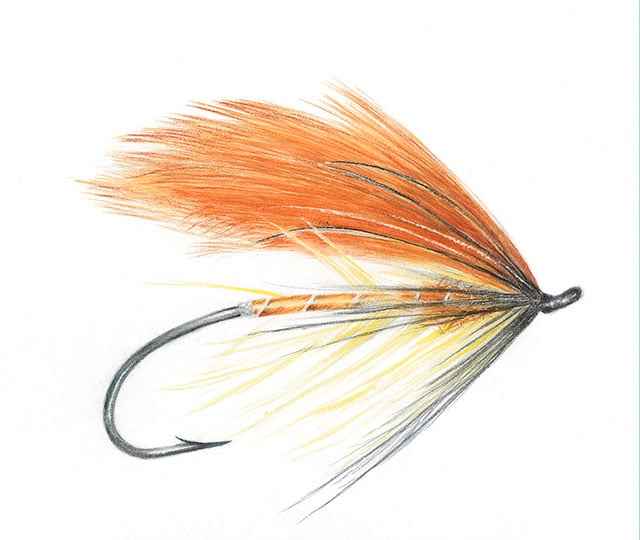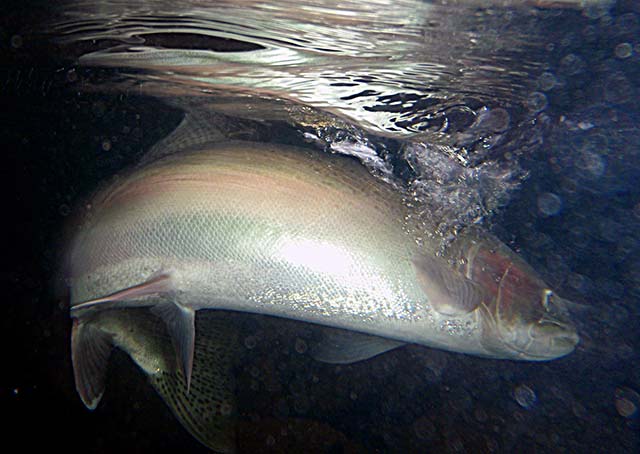“Sol Duc Spey”

Sol Duc Spey Fly illustration by Julie Spyropoulos
When Syd Glasso began tying his first steelhead versions of Spey flies in the late 1950s, he gave birth to an entirely new family of flies, one that still thrives more than half a century later. Glasso’s attention to detail and careful selection of just the right materials made his flies outstanding works of art. While the Spey form is still evident, the Steelhead Speys are sleeker, more sparsely tied, and, above all, more brightly colored than any traditional Scottish fly ever dreamed of becoming.
Specifically Pacific
Syd Glasso was a schoolteacher in the small town of Forks on the Olympic Peninsula in Washington State, virtually within casting distance of some of the finest steelhead rivers in the Pacific Northwest. As well as being a keen and accomplished steelheader, he was an expert Spey flytier (a classic Spey fly tied by Glasso recently went on sale for $1,500!), and he took what seemed to him a natural step—offering a version of the Scottish Spey fly, designed to entice the Atlantic salmon, to its Pacific cousin.

Found in Pacific-bound rivers from southern California to Alaska, the steelhead is a sea-run rainbow trout that returns to fresh water to spawn. Unlike Pacific salmon, the majority of steelhead go back to the ocean after spawning and return repeatedly.
Up until the mid 1950s, wet-fly steelhead anglers in this area had been using bucktail, hairwing and spider patterns, but here was something new. Unlike the true Spey fly, the Sol Duc Spey—named after Syd’s local river—was slim and bright, with an orange body, yellow body hackles, a red head and four flaming orange hackle tips tied in a tented formation on top of the hook for wings.
Visibility was key, but the racy body style allowed the fly to sink quickly down to the fish, unlike its fatter forebears, and the exposed hook acted like a keel to hold the fly upright in the current.
Catching On
It was a killer. Fishing the Sol Duc River, Glasso caught five steelhead the first time he used his new fly, and soon a small group of his friends were using this and several other classic Glasso patterns, most of them based on Spey fly principles. It didn’t take long for further evolution to take place in the hands of such renowned tiers as Dick Wentworth, Pat Crane, and Walt Johnson, but it took a good many years before the Steelhead Speys found favor with a much wider audience. Now they are to be found catching fish throughout the Pacific Northwest, from Oregon to the famous rivers of northern British Columbia—such as the Skeena, Bulkley, Maurice and Babine—and Syd Glasso’s influence is undoubtedly behind the popularity of fly tying on the West Coast over the last 30 years.

The Sol Duc River, which flows from the Olympic Mountains in Washington State, offers ideal conditions for the steelhead and a challenge for the angler in pursuit of the “fish of a thousand casts.”
In an article entitled “The Olympic Peninsula,” published in The Creel magazine in 1970, Glasso wrote, “I like Spey type flies for winter steelheading and have used them for over twenty years. The style is over a century old, they’re easy to tie and they look seductive in the water. The fish take them solidly and that’s enough for me.” Many would argue that they are far from easy to tie well, but fish certainly take them solidly.
Excerpted from “The History of Fly-Fishing in Fifty Flies” by Ian Whitelaw, illustrations by Julie Spyropoulos © Stewart, Tabori & Chang, 2015. Buy “The History of Fly-Fishing in Fifty Flies” in the MidCurrent store.











